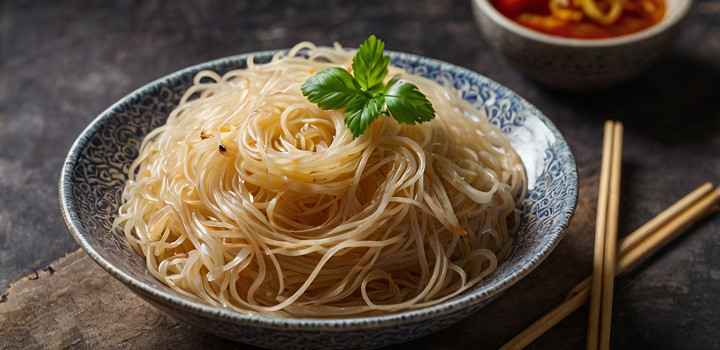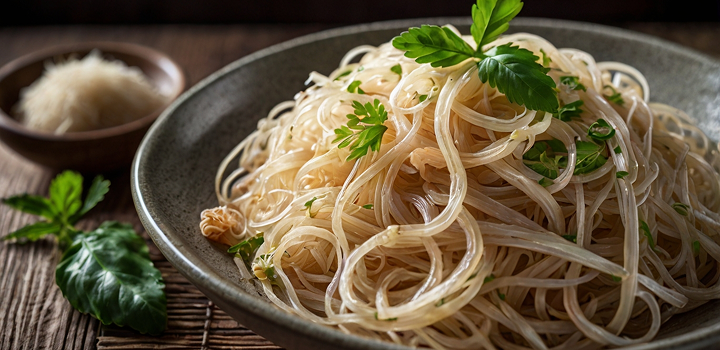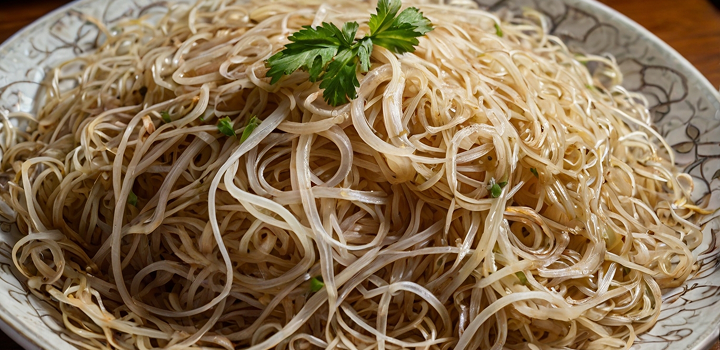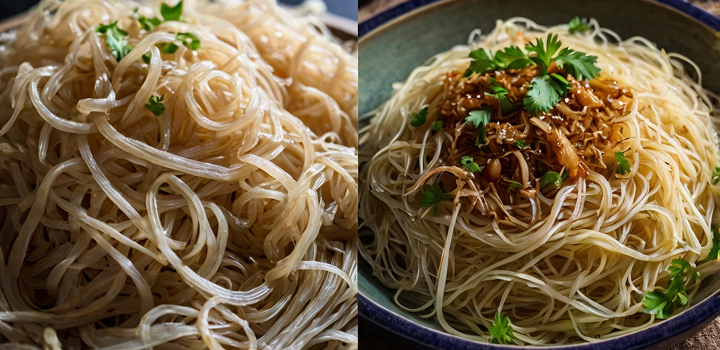Mastering Vermicelli
Mastering Vermicelli: A Step-by-Step Guide to Cooking It Right Every Time

Author: Arianne Nemna
Vermicelli might look delicate, but it’s one of the most versatile ingredients in the global pantry. Whether you’re building a fragrant bowl of Vietnamese bún, tossing a fast stir-fry, or preparing comforting Mexican fideo, the way you handle vermicelli determines the final texture, taste, and structure of your dish. In this guide, I’ll break down exactly what vermicelli is, the types you’ll encounter, and how to confidently select, prepare, and cook it—no clumping, overcooking, or confusion involved. Let’s begin with the basics before we step into cooking techniques and cultural pairings.
- What Is Vermicelli? Varieties & Nutritional Overview
- Choosing the Right Vermicelli for Your Dish
- Prep Techniques: Soaking vs. Boiling
- Cooking Vermicelli: Best Practices
- Common Pitfalls & Troubleshooting
- Cooking Vermicelli for Specific Dishes
- Storage, Reheat & Leftovers
- 15+ FAQs: Solving Vermicelli Cooking Questions
What Is Vermicelli? Varieties & Nutritional Overview
Origins & Types

Vermicelli translates from Italian as “little worms,” but the ingredient itself stretches far beyond one region. What qualifies as vermicelli can vary based on where you are and which cuisine you’re cooking.
Rice vermicelli vs. bean-thread/glass noodles
Rice vermicelli is made from ground rice and water, producing thin, white noodles that become soft and slightly springy when soaked or boiled. It’s a staple in Southeast Asian cuisines like Thai, Vietnamese, and Malaysian cooking. These noodles cook quickly and absorb the flavors of sauces and broths well.
Bean-thread noodles, also known as glass noodles or cellophane noodles, are made from mung bean starch. When cooked, they become transparent and slippery. While visually similar in their dry form, glass noodles behave differently when cooked and are not true rice vermicelli. They work well in hot pots and stir-fries but require a gentler soak or simmer.
Italian-style (durum wheat) vermicelli
In Western cuisine, especially Italian, vermicelli refers to a pasta similar in appearance to spaghetti but slightly thinner. Made from durum wheat semolina, this version holds up well to boiling and is often served with sauces or in soups. Unlike rice vermicelli, Italian-style is boiled like traditional pasta and does not require rinsing after cooking.
Nutritional Profile & Best Uses
Rice vermicelli is gluten-free, low in fat, and relatively neutral in taste, making it an excellent base for high-flavor dishes. On average, a cooked cup of rice vermicelli delivers about 190 calories, primarily from carbohydrates. It provides little protein or fiber unless combined with vegetables and meat.
Italian-style vermicelli is higher in protein and calories due to its wheat content, averaging around 220 calories per cup cooked. It’s best used in Western-style pasta dishes, while rice vermicelli suits Asian soups, salads, and rolls.
Glass noodles are starch-dense, more translucent when cooked, and slightly chewier. They’re often used where a clear, slippery texture is needed, such as in Korean japchae or Chinese hot pot.
Here’s a quick nutritional comparison table per 100g cooked:
| Type of Vermicelli | Calories | Carbs (g) | Protein (g) | Gluten-Free |
| Rice Vermicelli | 190 | 43 | 1.5 | Yes |
| Italian (Durum Wheat) | 220 | 44 | 7.0 | No |
| Glass Noodles (Mung Bean) | 160 | 39 | 0.5 | Yes |
Choosing the Right Vermicelli for Your Dish
Matching Vermicelli to Cuisine (Vietnamese, Chinese, Indian, Latin American)

Vermicelli plays different roles depending on the cuisine. In Vietnamese cooking, rice vermicelli is commonly served in chilled bowls with grilled meat, herbs, and dipping sauce. In Chinese cuisine, it’s found in soups or stir-fries, sometimes even pan-fried into crisp nests.
In Indian cuisine, vermicelli (often called semiya) is used in both sweet and savory dishes—ranging from creamy kheer to savory upma. Latin American cooking introduces us to fideo, a thin noodle sautéed before simmering in tomato-based broths or soups, typically using wheat-based vermicelli.
Understanding the origin of the dish you’re preparing can help you choose the appropriate type—boiled, soaked, stir-fried, or simmered.
How to Read Packaging & Select Quality Brand
Thickness, material & opacity as indicators
When selecting a package of vermicelli, the visual and textual cues can tell you a lot. Rice vermicelli should be thin, dry, and opaque white—not translucent. Avoid packages with broken strands or signs of moisture. Check the label for ingredients: the best rice vermicelli contains only rice flour and water.
If the packaging says “glass noodles” or lists mung bean starch, it’s not rice vermicelli. Italian-style vermicelli should have a golden color and consistent strand thickness.
Recommended brands (e.g. Bamboo Tree, Three Ladies)
For rice vermicelli, brands like Bamboo Tree, Three Ladies, and Twin Dragon consistently offer reliable quality and cook times. These brands often include instructions for both soaking and boiling, which is helpful for beginners. For Italian-style wheat vermicelli, Barilla and De Cecco are trusted names with consistent performance in boiling and saucing.
Prep Techniques: Soaking vs. Boiling
Soaking Method (Cold or Hot Water)

Not all vermicelli needs boiling. In fact, for many rice-based varieties, soaking is not only sufficient—it’s preferred. Soaking helps retain the noodles’ natural chewiness and keeps them from turning to mush. You’ll typically find two approaches: cold soaking and hot soaking. The method you choose depends on how the noodles will be used and what texture you’re aiming for.
When soaking is enough (springy texture, no pot needed)
When making cold noodle salads, Vietnamese bún bowls, or spring rolls, soaking dry rice vermicelli in warm water for 10 to 20 minutes is often all that’s needed. The noodles gradually soften without releasing excess starch, which helps them stay bouncy and separate once drained.
Cold water can also be used, especially if the noodles are very fine or you’re prepping ahead. This method takes longer—up to 30 minutes—but gives you maximum control over the final texture. After soaking, simply drain and toss the noodles with your prepared dish or briefly flash them in hot water for 10 seconds to warm through.
Boiling for Fresh & Dried Noodles
Boiling is more common when dealing with thicker vermicelli or recipes that call for piping-hot results, like soups and stir-fries. It’s also the go-to for wheat-based vermicelli, such as in Indian or Italian preparations.
Timing: 2–5 minutes depending on brand
Once your water is boiling, drop in the vermicelli and gently stir. Most dried rice vermicelli will cook in 2 to 4 minutes. Wheat-based types, like semiya or Italian vermicelli, may take closer to 5 minutes. Always check the instructions on the package, but don’t rely on them alone. Cooking time can vary slightly based on the thickness of the noodle and the intensity of your boil.
Checking doneness – springy, al dente
The noodles are ready when they become soft but still have a slight bite—think of “al dente” pasta. The strands should hold their shape and bounce slightly when pinched. Overcooked vermicelli will turn gummy or break apart when stirred into a dish. When in doubt, taste a strand. If it’s soft on the outside with a subtle core resistance, you’re good to go.
Cooking Vermicelli: Best Practices
Using Plenty of Water & Stirring to Avoid Clumps

Vermicelli strands are thin and prone to sticking, especially when cooking a large batch. The best approach is to use a wide pot with plenty of boiling water. The moment the noodles go in, gently stir them with chopsticks or tongs to separate strands and keep them moving. A rolling boil helps prevent clumps and ensures even cooking. If the noodles sit still for too long, they’ll tangle and become impossible to separate later.
Rinse & Cool Post Cooking
When the noodles have reached the desired texture, they need to be removed from heat immediately. This halts the cooking process and prevents them from going soft or sticky as they cool.
Stop cooking & remove starch—cold water rinse
Rinsing vermicelli under cold running water serves two functions: it stops carryover cooking, and it washes away excess surface starch. Hold a colander under the tap and swish the noodles until fully cooled. This makes them less likely to clump and more absorbent of sauces or dressings. For cold dishes or make-ahead meals, this step is essential.
Alternative Techniques for Texture
Not every dish needs boiling water. In fact, alternative methods can enhance specific textures or presentation.
Cold soak only (no boiling)
Some recipes benefit from the cold-soak method where noodles are softened in room-temperature or cold water without any heat. This is particularly useful when you want a firmer bite, such as for fresh salads, or when preparing meals that will later be cooked with other ingredients in a hot pan. Cold soaking offers the cleanest, least starchy texture.
No rinse – steam-dry method for certain dishes
In a few dishes, especially in Indian-style preparations like semiya upma, rinsing is skipped altogether. Instead, the noodles are lightly boiled or par-cooked and then added directly into a pan to steam-dry as they absorb moisture from sautéed vegetables and spices. This method gives you a more cohesive dish where the noodles hold their structure and absorb flavor without dilution from rinsing.
Common Pitfalls & Troubleshooting
Overcooked & Mushy Noodles

One of the most common issues when cooking vermicelli is overcooking. Because the noodles are so thin, a few extra seconds in hot water can turn them from springy to soggy. Overcooked noodles tend to lose structure and become gluey, especially in soups or stir-fries.
How to rescue with cold soak or quick rinse
If you’ve gone a little too far with the cook time, drain the noodles immediately and rinse them under cold running water. This halts the cooking and tightens the surface starch. In some cases, soaking the noodles in an ice bath for a minute or two can help reverse some of the mushiness, especially with rice vermicelli. For mild overcooking, draining thoroughly and letting the noodles rest uncovered for 5–10 minutes can also firm them up slightly.
Sticky or Clumpy Vermicelli
When vermicelli clumps, it’s often due to not stirring early in the cooking process or skipping the rinse after boiling. Clumps lead to uneven texture and poor sauce absorption, especially in cold dishes or noodle bowls.
Stirring, rinse, and toss with a little oil
Always stir the noodles right after adding them to water. After cooking, rinsing under cold water separates the strands. If the noodles are still sticky, drizzle in a small amount of neutral oil—like canola or sesame—and gently toss by hand. This coating helps keep the strands separate, especially when prepping in advance or serving cold.
Tearing out and re-soaking
If noodles have clumped together post-drain, try tearing out a portion and soaking it again briefly in warm water. This works best for rice vermicelli. Gently loosen the strands with chopsticks or your fingers while soaking until they separate. Be careful not to break them.
Cooking Vermicelli for Specific Dishes
Soups & Broths
When using vermicelli in soup, the biggest mistake is boiling them directly in the broth. While convenient, this clouds the broth and overcooks the noodles.
Parboil separately to avoid soggy broth
Instead of cooking noodles in your soup base, parboil them separately and add them to bowls just before serving. This keeps the broth clear and allows diners to enjoy the distinct texture of the noodles. It also avoids flavor dilution from excess starch. After parboiling, rinse the noodles in cold water and portion into serving bowls before ladling in hot soup.
Stir-Fries & One-Pan Recipes
For dishes like Singapore noodles or pad woon sen, vermicelli needs to absorb flavor directly from the wok.
Cook noodles in pan or wok with veggies & sauce
Start with soaked or parboiled vermicelli and add them to the hot pan only after your vegetables and protein are nearly done. Toss vigorously to coat the noodles in the sauce. If they begin to stick, add a splash of water or broth. Timing is critical—overcooked vermicelli will tear apart under stir-fry pressure.
Here’s a quick timing guide by method:
| Method | Prep Needed | Add to Pan When… | Cooking Time in Pan |
| Soaked (no boil) | Soft but firm | Veggies 80% done | 2–3 minutes |
| Parboiled | Rinsed and drained | Protein is seared | 1–2 minutes |
Cold Vermicelli Salads & Bowls
Cold vermicelli dishes like Vietnamese bún or Thai yum woon sen are refreshing and perfect for warm weather. But texture is key.
Chill after rinse, add fresh herbs, proteins
After cooking, rinse the noodles under cold water until completely cooled. Chill them in the fridge while you prep herbs, proteins, and dressings. This prevents the noodles from softening further. Once cold, toss them gently with ingredients like mint, cilantro, grilled meat or tofu, crushed peanuts, and lime-based sauces. The noodles should remain firm and distinct.
Ethnic Variations & Recipes
Vermicelli is not a one-dish ingredient. It’s woven into global cuisines, each with its own method and purpose.
Mexican fideo in tomato broth
This dish uses wheat-based vermicelli that’s first toasted in oil to develop a nutty flavor. Then, it’s simmered in a tomato and garlic broth until tender and deeply infused with flavor. This toasting step distinguishes fideo from other noodle soups, adding body and aroma.
Indian semiya upma – breakfast vermicelli
Semiya upma is a savory breakfast dish made by sautéing dry wheat vermicelli in oil with mustard seeds, curry leaves, onion, and chopped vegetables. Hot water is added gradually, allowing the noodles to absorb it fully as they steam. This method eliminates the need to rinse or pre-cook.
Here’s a visual breakdown of the Indian-style cooking method:
| Step | Action |
| Dry roast semiya | Golden brown in oil |
| Add aromatics | Mustard seed, curry leaf, onion |
| Pour hot water | About 1:1.5 ratio with vermicelli |
| Steam cook | Cover and simmer until water absorbed |
Southeast Asian dishes: mee siam, bihun goreng
Mee siam features rice vermicelli in a tangy tamarind broth, often topped with boiled egg, bean sprouts, and tofu. Bihun goreng, on the other hand, is a dry fried noodle dish from Malaysia or Indonesia where soaked rice vermicelli is stir-fried with soy sauce, chili paste, shrimp, and vegetables. In both, the noodles are soaked—not boiled—before being stir-fried or steeped in sauce.
Storage, Reheat & Leftovers
Fridge & Freezer Storage Tips
Cooked vermicelli can be stored for later use, but the texture depends entirely on how it’s cooled and stored. Once cooked and rinsed, let the noodles cool fully before transferring them to a container. Store them in an airtight container in the refrigerator for up to 3 to 4 days. If possible, toss them with a few drops of oil to prevent sticking before sealing the lid.
Freezing is possible but should be a last resort. Vermicelli often becomes brittle or mushy after thawing, especially if it’s made from rice or mung bean starch. To freeze, portion the noodles into single servings, wrap tightly in plastic wrap or parchment paper, and store in a freezer-safe bag. Use within one month for best texture.
Here’s a quick reference:
| Storage Method | Ideal Duration | Texture Outcome |
| Refrigeration | 3–4 days | Good if rinsed and oiled |
| Freezing (rice type) | 1 month | Risk of brittleness/mushiness |
| Freezing (wheat type) | 1–2 months | More stable after thawing |
Reheating Without Clumping
Reheating vermicelli without turning it into a tangled mass takes care and the right method. The goal is to revive the texture while keeping strands separate and springy.
Microwaving with splash of water & gentle toss
Place the vermicelli in a microwave-safe bowl, sprinkle a small amount of water over the top (just enough to create steam), and cover loosely with a lid or plate. Microwave on medium power for 30 to 60 seconds. After heating, gently separate the strands with chopsticks or a fork. This works well for rice vermicelli and wheat varieties alike.
Steam or hot water refresh for cold dishes
For cold dishes or leftover noodles you want to serve warm, the steam or hot water method works better. Place the vermicelli in a colander or mesh strainer and hold it over a pot of boiling water for 30 seconds to 1 minute. Alternatively, dunk the noodles into freshly boiled water, stir gently, and drain immediately. This reactivates the original softness without making them mushy.
15+ FAQs: Solving Vermicelli Cooking Questions
How do I keep vermicelli from sticking together?
Always stir the noodles gently as they’re cooking, then rinse thoroughly in cold water afterward. If preparing for later use, coat lightly with oil to keep strands separate during storage.
What’s the best way to know when vermicelli is done?
Check the texture by biting into a strand. It should be tender with a slight bite—never mushy. For rice vermicelli, if it becomes transparent and pliable, it’s usually ready.
Can I soak instead of boil vermicelli?
Yes, many rice vermicelli varieties are designed to be soaked in warm or hot water instead of boiled. This preserves their texture, especially for salads and rolls. Always read the packaging.
Why does my vermicelli turn out mushy?
This happens when noodles are boiled too long or not rinsed properly. Use a timer, taste-test early, and rinse immediately after cooking to halt the process.
What type of vermicelli is best for stir-fries?
Rice vermicelli that has been soaked (not boiled) works best. Soaked noodles are more durable and absorb sauces evenly without breaking down.
Can I use spaghetti instead of vermicelli?
You can substitute spaghetti or angel hair pasta in Western-style dishes, but the texture and starch content are different. For Asian recipes, use rice vermicelli for authenticity.
Do I need to rinse vermicelli after boiling?
Yes, especially rice-based vermicelli. Rinsing removes excess starch, stops the cooking, and prevents clumping.
What happens if I skip soaking?
Skipping soaking may lead to unevenly cooked noodles, especially if the recipe depends on them softening in broth or sauce. Soaking also reduces cook time and clumping.
Is vermicelli gluten-free?
Rice and glass vermicelli are gluten-free. Wheat-based types like Italian vermicelli and Indian semiya contain gluten.
Can I prep vermicelli in advance?
Yes. Cook, rinse, and toss in oil. Store chilled in an airtight container. Reheat gently before using in your dish.
How do I avoid breakage when stir-frying?
Soak, don’t boil. Then stir-fry over medium heat, using a light hand and tossing gently. Add sauces after the noodles to coat them without excess friction.
What’s the best vermicelli for soup?
Use rice vermicelli for clear broths or mung bean noodles for a slippery texture. Always parboil separately and add to bowls before pouring broth.
Can I reuse leftover vermicelli in other dishes?
Absolutely. Use them in stir-fries, omelets, spring rolls, or fried into crunchy toppings. Cold noodle bowls are another easy remix.
Do thicker vermicelli need different treatment?
Yes. Thicker strands often need boiling rather than soaking and require more careful timing to stay al dente.
What’s the difference between rice vermicelli and glass noodles?
Rice vermicelli is white and made from rice flour; it turns soft and slightly chewy when cooked. Glass noodles are transparent, made from mung bean starch, and more slippery.







